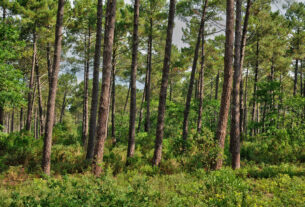Throughout April, we are featuring the articles shortlisted for the 2022 Harper Prize. The Harper Prize is an annual award for the best early career research paper published in Journal of Ecology. Jorge Isla’s article ‘Drivers of individual-based, antagonistic interaction networks during plant range expansion‘ is one of those shortlisted for the award.
⭐️About me
I grew up in a village near the Pyrenees in northern Spain, where I developed a fascination and admiration for nature from an early age. At the age of eighteen I moved to Andalusia to study Environmental Sciences, which opened the doors to scientific research and the study of ecology. During my university studies, I was lucky to work in Pedro Rey’s ecology group, where I discovered ecological field research and the study of plant-animal interactions. This experience awakened my interest in ecological research and led me to work as a field technician in this group for two years. I decided to prepare myself for a thesis project, so I took a master’s degree at the Pablo de Olavide University in Seville. Through this master’s degree I came into contact with the Doñana Biological Station (CSIC), where I am currently doing my PhD. There I met Pedro Jordano and Miguel Jácome, two researchers at the centre who are experts in the study of plant-animal interactions. They trusted me to start a thesis project, on which I have been working and learning for more than three years.
Through my dissertation project I aim to improve our knowledge on the configuration of plant-animal interactions during plant expansion scenarios. For this purpose, we analyze both interactions that may be slowing down natural regeneration processes (e.g. pre-dispersal seed predation) and those that may be facilitating them (e.g. seed dispersal by frugivores or mycorrhizal symbiosis). My research pivots on three main points: detailed field data on interactions and their effects, natural history of these interactions, and an integrative network framework. This network approach allows us to unravel how different types of interactions are structured along natural colonization gradients at the individual level, as well as their main drivers. One of the most interesting challenges that we tackle is to apply network tools from other research fields (e.g. multilayer networks), which allow us to analyze in a holistic way the importance of these interactions during plant expansion processes.
🔎About the shortlisted article
The study, ‘Drivers of individual-based, antagonistic interaction networks during plant range expansion‘, represents the first chapter of my dissertation project, and is also the first scientific publication that I have led to date. In this work, we analyze the interaction network between a diverse community of pre-dispersal seed predators (birds, rodents, and invertebrates) and individual plants of a pioneer shrub species (Juniperus phoenicea).

Using innovative, individual-based interaction networks and ERGM models we document interactions turnover and network reconfigurations along the range shift. Seven pulp-seed consumer animal species varied significantly in their frequency of interaction and prevalence. Individual plant traits strongly determined the topology of these networks, although with differences along the expansion gradient. Antagonistic load at the colonization front was concentrated in a reduced subset of plants, where invertebrate species showed reduced interaction weights. However, the disproportionately large effect of avian seed predators potentially results in large seed losses during range expansion. We found no evidence of a complete antagonist release at the colonization front but resulting in more heterogeneous interaction strengths among individual plants.

Figure 3 (right): Plant-animal antagonist networks (top; plants, colored nodes; animals, black nodes) are reshaped during range shifts towards colonization fronts (green) from more mature stands (brown).
Until now, we did not know that plant-animal interactions could be varying in this specific ecological context or at such a local scale. The fact that a natural regeneration process is not being facilitated by a release of antagonists leads us to think that perhaps mutualistic interactions, such as seed dispersal, are compensating for these negative effects. Our most recent results on seed dispersal by frugivores support this compensation hypothesis. This research highlights the scale at which natural plant interactions are organized in the environment, as well as their drivers and consequences.

Find Jorge on Twitter and Google Scholar.
Read the full list of articles shortlisted for the 2022 Harper Prize here.

